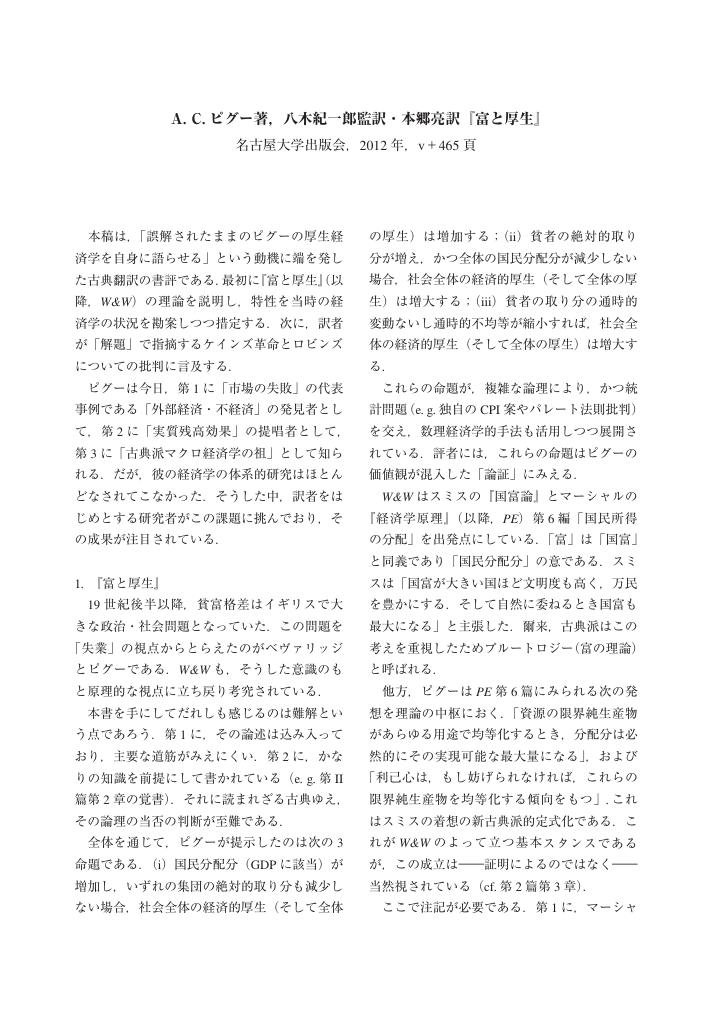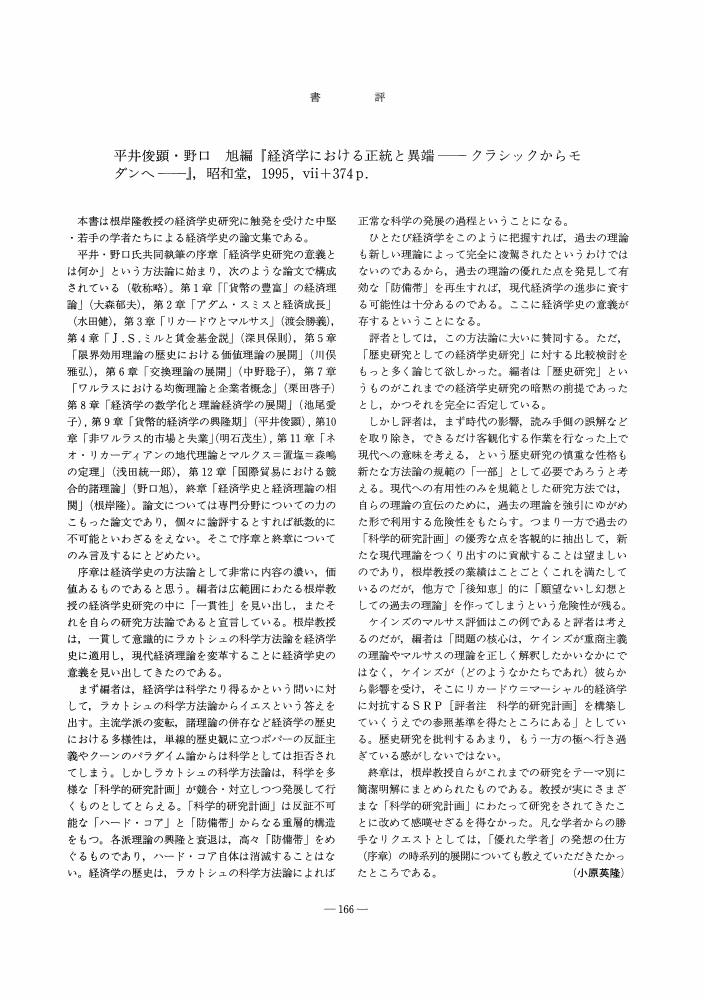2 0 0 0 OA 『確率論』と「若き日の信条」
- 著者
- 平井 俊顕
- 出版者
- The Japanese Society for the History of Economic Thought
- 雑誌
- 経済学史学会年報 (ISSN:04534786)
- 巻号頁・発行日
- vol.42, no.42, pp.18-31, 2002 (Released:2010-08-05)
- 参考文献数
- 35
The purpose of this paper is to examine Keynes as a philosopher in view of the relation among A Treatise on Probability (1921), Ramsey's criticism (1926), Keynes' acceptance of Ramsey's criticism (1931), “My Early Beliefs” (1938), and Keynes' criticism of Tinbergen (1939).The conclusion is as follows:(1) In his youth, Keynes firmly believed in human rationality, as described in his philosophical work, A Treatise on Probability and his memoir, “MyEarly Beliefs.” However, in the midst of the chaos of post-WW 1 Europe he became more and more skeptical of human rationality and showed a greater awareness of the emotional aspect of human nature, which is typically shown in his criticism of the market society and his advocacy of the New Liberalism in The End of Laissez-Faire (1926). As the years went by, Keynes' skepticism became deeper and deeper and came to stress the importance of custom and tradition, while he came to revalue the market society in face of the realities of the Soviet society.(2) Keynes abandoned the most essential part of his A Treatise on Probability, which regards probability as degrees of rational belief between propositions, and the justification of induction based on it, in the face of Ramsey's criticism. This is evidently recognizable in his obituary of Ramsey and “My Early Beliefs”. However, he did not abandon his theory of probability completely, which is shown in his critical review of Tinbergen (1939). In Part V (The Foundations of Statistical Inference) of A Treatise on Probability, Keynes had criticized the mathematical use of statistical frequencies (Methods of Laplace) and defended the inductive use of them (Methods of Lexis). Keynes' criticism of Tinbergen's method is mainly based on this stance. We have Keynes who accepted Ramsey's criticism on the one hand, and retained the Methods of Lexis on the other. A logical fissure seems to run between Part III (Induction and Analogy) and Part V.
- 著者
- 平井 俊顕
- 出版者
- 経済学史学会
- 雑誌
- 経済学史研究 (ISSN:18803164)
- 巻号頁・発行日
- vol.55, no.2, pp.134-136, 2014 (Released:2019-11-28)
- 参考文献数
- 2
- 著者
- 平井 俊顕
- 出版者
- 経済学史学会
- 雑誌
- 経済学史研究 (ISSN:18803164)
- 巻号頁・発行日
- vol.52, no.1, pp.118-119, 2010 (Released:2019-10-25)
- 著者
- 平井 俊顕
- 出版者
- 経済学史学会
- 雑誌
- 経済学史研究 (ISSN:18803164)
- 巻号頁・発行日
- vol.48, no.1, pp.146-148, 2006-06-30 (Released:2010-08-05)
- 著者
- 平井 俊顕
- 出版者
- 経済学史学会
- 雑誌
- 経済学史学会年報 (ISSN:04534786)
- 巻号頁・発行日
- vol.45, no.45, pp.86-89, 2004 (Released:2010-08-05)
1 0 0 0 OA ケインズ研究の動向
- 著者
- 平井 俊顕
- 出版者
- The Japanese Society for the History of Economic Thought
- 雑誌
- 経済学史学会年報 (ISSN:04534786)
- 巻号頁・発行日
- vol.39, no.39, pp.74-80, 2001 (Released:2010-08-05)
- 参考文献数
- 53
The purpose of this paper is to survey recent studies of Keynes's theory which deal with A Treatise on Money and The General Theory. In Section 1, studies of A Treatise on Money are discussed in view of (i) the determination of price and output, (ii) monetary theory, and (iii) its relation to Wicksellian theories. In Section 2, studies of Keynes's theoretical development between the two books are examined. In Section 3, studies of The General Theory, mainly by post-Keynesians and neo-Ricardians, and partially by Income-Expenditure Keynesians are discussed. And in Section 4, studies of the relation between the two books are examined in terms of discontinuity and continuity.
- 著者
- 平井 俊顕
- 出版者
- The Japanese Society for the History of Economic Thought
- 雑誌
- 経済学史学会年報 (ISSN:04534786)
- 巻号頁・発行日
- vol.36, no.36, pp.128-137, 1998 (Released:2010-08-05)
- 参考文献数
- 17
1 0 0 0 OA ケンブリッジ学派における2つの流れ
- 著者
- 平井 俊顕
- 出版者
- The Japanese Society for the History of Economic Thought
- 雑誌
- 経済学史学会年報 (ISSN:04534786)
- 巻号頁・発行日
- vol.30, no.30, pp.86-90, 1992 (Released:2010-08-05)
- 参考文献数
- 49
1 0 0 0 OA Kahn, R. F., The Making of Keynes' General Theory. Cambridge University Press, 1984. pp. xxv+305
- 著者
- 平井 俊顕
- 出版者
- The Japanese Society for the History of Economic Thought
- 雑誌
- 経済学史学会年報 (ISSN:04534786)
- 巻号頁・発行日
- vol.23, no.23, pp.65, 1985 (Released:2010-08-05)
1 0 0 0 IR ケインズの市場社会観 (<特集> 時代環境と子どもの運命)
- 著者
- 平井 俊顕
- 出版者
- 上智大学
- 雑誌
- ソフィア : 西洋文化ならびに東西文化交流の研究 (ISSN:04896432)
- 巻号頁・発行日
- vol.43, no.3, pp.57-71, 1994







